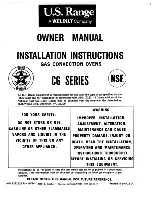
How it works
en
35
WARNING ‒ Risk of fire!
Opening the appliance door creates a draught.
Greaseproof paper may come into contact with the
heating element and catch fire.
▶
Never place greaseproof paper loosely over ac-
cessories when preheating the appliance and while
cooking.
▶
Always cut greaseproof paper to size and use a
plate or baking tin to hold it down.
20.3 Tips for keeping acrylamide levels low
during cooking
Acrylamide is harmful to your health and is produced
when you cook cereal and potato products at very high
temperatures.
Dish
Tip
General
¡
Keep cooking times as
short as possible.
¡
Brown dishes until they
are golden brown and
not too dark.
¡
Use large, thick pieces
of food. These contain
less acrylamide.
Baked items and biscuits
¡
Set the temperature for
hot air to max. 180 °C.
¡
Brush baked items
and biscuits with egg
or egg yolk. This re-
duces the production
of acrylamide.
Oven chips
¡
Spread the chips out
evenly and in a single
layer on the baking
tray.
¡
Cook at least 400 g at
once on a baking tray
so that the chips do
not dry out.
20.4 Tips for defrosting and heating
Follow these tips for good results when defrosting and
heating.
Issue
Tip
The food should be de-
frosted, hot or cooked
once the time has
elapsed.
Set a longer cooking
time. Larger quantities
and food which is piled
high require longer times.
Once the time has
elapsed, the food should
not be overheated at the
edge and cooked in the
middle.
¡
Stir the food occasion-
ally.
¡
Set a lower microwave
power setting and a
longer cooking time.
Issue
Tip
After defrosting, poultry or
meat should not be de-
frosted on the outside
only but still frozen in the
middle.
¡
Set a lower microwave
power setting.
¡
If you are defrosting a
large quantity, turn it
several times.
The food should not be
too dry.
¡
Set a lower microwave
power setting.
¡
Set a shorter cooking
time.
¡
Cover the food.
¡
Add more liquid.
20.5 Tips for defrosting and heating with the
microwave
If something goes wrong when defrosting or heating
food with the microwave, you can find some tips here.
Issue
Tip
You cannot find any in-
formation about the set-
tings for the quantity of
food you have prepared.
Increase or reduce the
cooking time.
Rule of thumb: Double the
quantity = almost double
the time; half the quantity
= almost half the time
Your food has become
too dry.
¡
Reduce the cooking
time.
Or:
¡
Select a lower mi-
crowave output setting.
¡
Cover the food and
add more liquid.
The time has elapsed but
your food is not defros-
ted, not hot or not
cooked.
Increase the cooking
time.
The time has elapsed but
your food is overheated at
the edge but not done in
the middle.
¡
Stir the food occasion-
ally.
¡
Next time, set a lower
output setting and a
longer cooking time.
After defrosting, your
poultry or meat is defros-
ted on the outside but not
defrosted in the middle.
¡
Next time, select a
lower microwave out-
put setting.
¡
If you are defrosting a
large quantity, turn it
several times.
20.6 Defrosting
With your appliance you can defrost frozen food.
Defrosting food
1.
Place the frozen food in an uncovered container on
the bottom of the cooking compartment.
Delicate parts such as the drumsticks and wings of
chicken or fatty outer layers of roasts can be
covered with small pieces of aluminium foil. The foil
must not touch the walls of the appliance.
2.
Start the operation.
















































